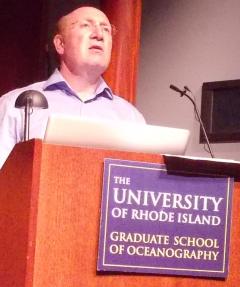
URI professor of oceanography Isaac Ginis. (Tim Faulkner/ecoRI News)
submitted by Sarah Slaughter
ecori.org - by Tim Faulkner - July 26, 2014
NARRAGANSETT — Hurricanes bound for New England will get about 10 percent more powerful by 2100, but the state lacks the tools to access their impacts, according to University of Rhode Island professor Isaac Ginis.
Hurricanes are powered by warm water, and the predicted increase in ocean temperatures caused by climate change is expected to make hurricane season longer and the storms stronger in the years ahead. .
. . . Numerous studies and models suggest the frequency of category 4 and 5 hurricanes are expected to increase by 81 percent, while the volume of rainfall is expected to increase 20 percent by 2100, Ginis said.
However, a key current modeling method used to measure the impacts of hurricanes and set flood insurance maps is outdated, he said.
(READ COMPLETE ARTICLE)
Recent Comments